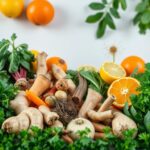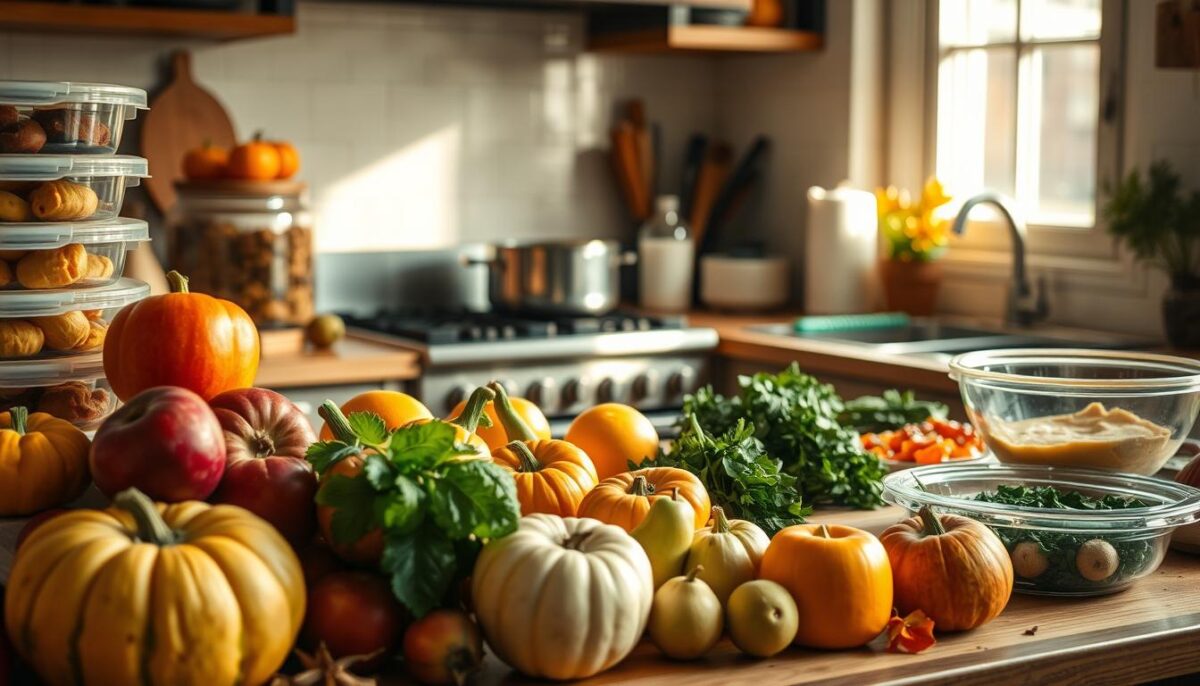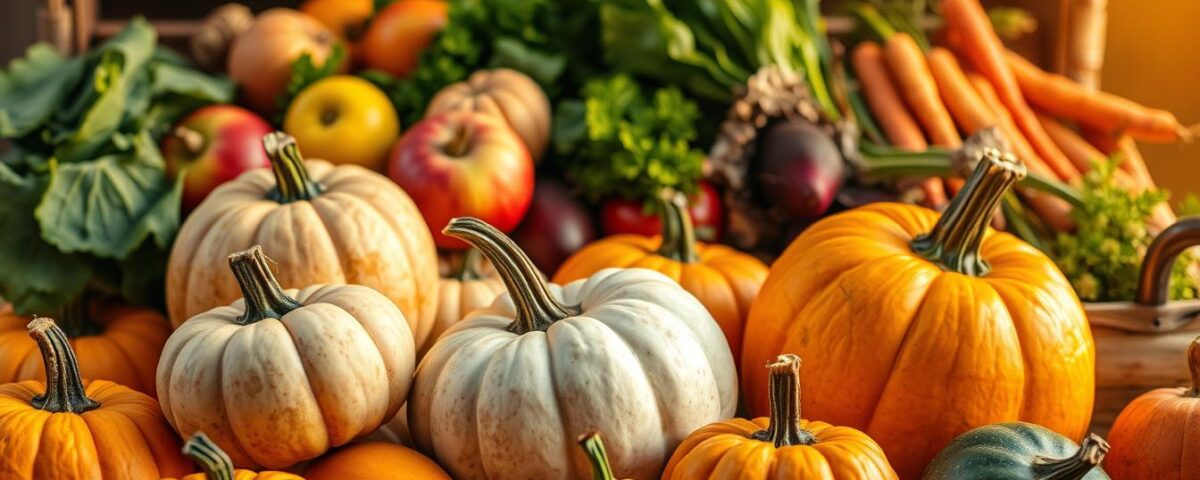
Why Seasonal Eating Matters and How to Start Today
May 9, 2025
Spring Detox Foods That Cleanse Your Body the Natural Way
May 10, 2025Did you know 70% of Americans don’t eat enough seasonal produce during autumn? That’s like skipping nature’s most vibrant health boosters when they’re at their peak. I used to overlook this too—until I realized how much better I felt after swapping summer berries for cozy, earthier flavors.
There’s something magical about crisp mornings and the way seasonal ingredients seem to hug your body with warmth. Take figs, for example. These sweet gems aren’t just for charcuterie boards—they’re loaded with polyphenols that fight inflammation. Or pumpkin, my go-to for soups and lattes, which packs more vitamin C than an orange. Every bite feels like a secret handshake with wellness.
I’ve found that leaning into what’s fresh right now isn’t just tasty—it’s smart. These choices naturally deliver fiber to keep digestion smooth and vitamins to armor up before cold season. Plus, they’re affordable and easy to find at local markets. Why settle for bland when you can have flavor and fuel?
Key Takeaways
- Autumn produce offers unmatched freshness and nutritional density
- Seasonal picks like figs provide antioxidants for cellular health
- Pumpkin delivers immune-boosting carotenoids and vitamin C
- High-fiber options support digestion and long-lasting energy
- Eating with the seasons can enhance both flavor and wellness
The Importance of Seasonal Nutrition
What if I told you your grocery cart could become a time capsule of wellness? Joy Bauer, renowned nutrition expert, puts it perfectly: “Eating seasonally is like syncing your plate with nature’s clock—it delivers maximum benefits with minimal effort.” When I shifted to autumn-focused meals, I discovered produce harvested at its prime packs more vitamins and minerals than items shipped cross-country.
Benefits of Eating Fall Produce
Local butternut squash changed my perspective. Studies show seasonal picks contain up to 40% more antioxidants than off-season counterparts. This matters because compounds like beta-carotene in orange veggies directly support heart health. My favorite hack? Roasting cubed squash with cinnamon—it caramelizes the natural sugars while preserving nutrients.
How Seasonal Foods Boost My Health
I’ve noticed fewer midday energy crashes since prioritizing autumn ingredients. The reason? Peak ripeness means higher fiber content, which stabilizes blood sugar. Last week, I made a creamy soup using butternut squash as the base—its velvety texture and earthy flavor made it feel indulgent, yet it was packed with vitamin A. That’s the magic of eating what’s in season: every meal becomes a source of both comfort and vitality.
Nutrient Rich Fall Foods: A Closer Look
Autumn’s harvest isn’t just about cozy flavors—it’s a science-backed wellness strategy. Let me show you how specific components in seasonal picks work together to keep your body humming through colder months.
Understanding the Power of Fiber and Vitamins
Last week, I tracked my meals and realized sweet potatoes alone gave me 4g of fiber daily—that’s 16% of my needs. Research shows fiber from autumn veggies helps maintain energy better than supplements. Take this table comparing my go-to sources:
| Food | Fiber (per cup) | Key Vitamin |
|---|---|---|
| Acorn Squash | 9g | Vitamin C (37% DV) |
| Brussels Sprouts | 4g | Vitamin K (274% DV) |
| Pears | 7g | Vitamin C (12% DV) |
What surprised me? Potassium levels in squash. One serving offers 25% more than bananas. This mineral keeps muscles functioning smoothly during winter workouts.
The Role of Antioxidants in Fall Diets
Cranberries changed my antioxidant game. USDA data shows they contain over 13,000 antioxidants per cup—more than blueberries! These compounds protect cells when temperatures drop. My morning oatmeal now gets a tart boost with dried cranberries.
Here’s why it matters: Cold weather stresses our systems. Antioxidants in apples (quercetin) and pumpkin (beta-carotene) create a defense team. I’ve noticed fewer seasonal sniffles since making this switch.
My nutritionist friend put it best: “Eating with the seasons isn’t poetic—it’s practical biology.” Every roasted veggie tray or spiced stew becomes intentional fuel. Why not let nature’s timing work for you?
Fruits That Energize My Autumn
When the air turns crisp, my kitchen becomes a playground for nature’s candy—apples and pomegranates. These vibrant gems do more than satisfy sweet cravings; they’re secret weapons against autumn fatigue. Last week, I swapped my afternoon coffee for a ruby-red pomegranate smoothie and felt energized for hours.

Apples and Pomegranates: A Delicious Duo
Apples deliver a crisp dose of vitamin C and quercetin, an antioxidant that helps combat seasonal stress. Pomegranates? Their jewel-like seeds pack 7g of fiber per cup—that’s 25% of your daily needs. I sprinkle them on oatmeal or mix into yogurt for sustained energy.
The natural sweetness of these fruits transforms everyday dishes. Try adding apple slices to kale salads or blending pomegranate into vinaigrettes. My favorite hack: simmer apples with cinnamon for a quick compote to top roasted sweet potatoes.
For heartier meals, I stir pomegranate seeds into quinoa bowls or add diced apples to butternut squash soups. This combo brings brightness to cozy stews too. It’s like getting a vitamin boost while savoring autumn’s best flavors.
Vegetable Varieties with Remarkable Health Benefits
My farmers market haul last week looked like a rainbow—deep green kale, orange butternut squash, and purple-tinged Brussels sprouts. These aren’t just pretty additions to my plate; each color represents unique compounds that keep my body thriving. Registered dietitian Amanda Frankeny confirms: “Diverse vegetable intake is like giving your cells a full toolkit for autumn challenges.”
Leafy Greens and Squash: Versatile Powerhouses
Kale became my go-to after learning one cup provides 684% of daily vitamin K needs. I toss it into soups or bake crispy chips. Butternut squash shines as a good source of vitamin A—it supports eye health during shorter daylight hours. Roasted with thyme, it becomes caramelized comfort in every bite.
Brussels Sprouts to Jicama: Unexpected Stars
Brussels sprouts surprised me most. When shredded raw into salads, they offer 137% of daily vitamin C per cup. Broccoli rabe adds bitter complexity to pasta while delivering iron for energy. Then there’s jicama—a crunchy root I slice into sticks for dipping. Its prebiotic fiber feeds gut bacteria linked to immunity.
| Vegetable | Key Benefit | Per Cup |
|---|---|---|
| Brussels Sprouts | Vitamin C Boost | 124% DV |
| Broccoli Rabe | Iron Content | 15% DV |
| Jicama | Prebiotic Fiber | 6.4g |
These vegetables transform meals into defense strategies. Last Tuesday, I roasted Brussels sprouts with maple syrup—their crispy edges and sweet glaze made getting 3x my daily vitamin K feel indulgent. That’s the beauty of autumn’s bounty: every dish delivers both flavor and health benefits without compromise.
Superfoods That Enhance My Immune System
My morning tea ritual changed when I discovered immune-boosting ingredients hiding in plain sight. Three unexpected heroes—figs, pumpkin, and mustard greens—now form my autumn defense trio. Each brings unique strengths to my plate while working together like a wellness dream team.

Figs: Nature’s Sweet Protectors
Though technically inverted flowers, figs deliver 55% more polyphenols than most common fruits. These compounds help repair cellular damage from seasonal stressors. I chop them into oatmeal or pair with goat cheese for savory snacks. Nutritionist Dr. Maya Feller notes: “Fig skins contain prebiotics that feed gut bacteria linked to immune response.”
Pumpkin’s Hidden Vitamin Power
Move over oranges—roasted pumpkin gives me 20% more vitamin C per cup. I blend it into smoothies or bake into protein muffins. The seeds get roasted with turmeric for crunchy salad toppings. This versatile gourd also provides zinc, crucial for white blood cell function during cold season.
Mustard Greens: The Spicy Defender
These peppery leaves became my salad game-changer. Research shows they boost antioxidant enzymes by 40% compared to spinach. I massage them with lemon to soften texture, then add to grain bowls. Sautéed with garlic, they make a bold side dish packing 120% daily vitamin K needs.
My favorite hack? Roasting cubed pumpkin with mustard greens and figs—the caramelized sweetness balances the greens’ bite. It’s proof that good food doesn’t just taste amazing; it builds resilience from the inside out. Why settle for basic when autumn offers such flavorful armor?
Creative Ways to Incorporate Fall Foods into My Meals
Last Tuesday, I accidentally turned roasted carrots into soup—and discovered autumn’s best kitchen hack. Now my cutting board becomes a launchpad for vibrant, wholesome creations. Chef Yotam Ottolenghi’s advice rings true: “Seasonal cooking isn’t about recipes—it’s about playful experimentation.”

Wholesome Soups, Salads, and Snacks
I roast trays of root veggies every Sunday—beets, parsnips, sweet potatoes. Blended with broth, they become velvety soup bases packed with nutrition. For salads, I toss massaged kale with apple slices and toasted walnuts. The crunch? Jicama sticks dipped in tahini. These simple swaps turn snacks into benefits-loaded fuel.
Simple Meal Prep and Roasting Techniques
Sheet-pan magic saves my weeknights. Brussels sprouts get halved and tossed with olive oil—roasted at 425°F until crispy. I blend steamed squash into oatmeal batter for nutrition-dense pancakes. Pro tip: Freeze portions of roasted veggies to add instant variety to grain bowls.
My favorite hack? Stirring pumpkin puree into morning oats. It adds creaminess plus benefits like vitamin A. For quick side dishes, I sauté greens with garlic while roasting main proteins. This approach lets me maximize veggies without extra effort—because delicious nutrition shouldn’t feel like homework.
Culinary Tips for Savoring Autumn Flavors
Last Thursday, my spice rack became my secret weapon against bland meals. A pinch of cinnamon transformed my morning oats, while ginger gave roasted veggies a zesty kick. These small tweaks taught me how to amplify autumn’s bounty without complicated recipes.
Spice Alchemy: Warming Up Your Plate
Cinnamon isn’t just for lattes—it boosts circulation during chilly days. I sprinkle nutmeg on mashed squash for depth, and fresh ginger brightens soups. See how these spices work their magic:
| Spice | Flavor Note | Health Perk |
|---|---|---|
| Cinnamon | Sweet warmth | Balances blood sugar |
| Nutmeg | Earthy richness | Aids digestion |
| Ginger | Peppery zing | Reduces inflammation |
Savoring Bites, Not Portions
I use salad plates for richer dishes—it tricks my eyes into feeling satisfied. Chewing slowly helps me notice when pumpkins’ natural sweetness shines. This mindful way prevents overeating while maximizing flavor.
Flavor Partnerships That Deliver
Roasted pumpkins crave olive oil’s fat to unlock their vitamin A. Tossing apples with walnuts creates crunch and protein. For creative ways to use autumn harvest, try my favorite pairing: caramelized pears with thyme-infused ricotta. It’s proof that smart combinations elevate every dish’s nutritional value.
These strategies help people enjoy seasonal meals twice—first through aroma, then through nourishment. Because autumn’s flavors deserve to be celebrated, not rushed.
Conclusion
This season’s harvest isn’t just colorful—it’s a blueprint for peak wellness. From figs bursting with antioxidants to pumpkin’s vitamin C punch, nature’s autumn lineup delivers what our bodies crave. I’ve found these ingredients work best when paired smartly—like drizzling olive oil on roasted veggies to boost nutrient absorption.
What excites me most? The endless options. Hearty soups simmering with squash, crisp salads dotted with pomegranates, or roasted Brussels sprouts glazed with maple. Each dish becomes a delicious way to support my immune system while savoring autumn’s flavors.
My biggest takeaway: Seasonal eating isn’t restrictive—it’s liberation. By letting fresh picks guide my meals, I’ve discovered new favorites and felt my energy soar. Why not roast that tray of root veggies tonight? Or blend a soup that warms from within? Your body—and taste buds—will thank you.
FAQ
What makes seasonal produce better than out-of-season options?
I love seasonal picks like pumpkin and butternut squash because they’re fresher, tastier, and often packed with higher vitamin content. They’re also budget-friendly and support local farmers!
How can I add more fiber to my autumn meals?
Try roasting Brussels sprouts or blending apples into morning oatmeal. Sweet potatoes and jicama are also great fiber-rich choices for salads or soups.
Which fall foods help boost my immune system?
I rely on mustard greens for vitamin C, pumpkin seeds for zinc, and figs for antioxidants. Pair them with ginger or turmeric in teas or stir-fries for extra benefits.
What’s a simple way to enjoy autumn flavors without heavy cooking?
Toss cubed squash or beets with olive oil, roast them, and add to grain bowls. Or blend roasted pumpkin into a creamy soup with a dash of cinnamon.
Are there quick snacks that use fall superfoods?
Absolutely! I slice apples with almond butter, bake kale chips, or mix pomegranate seeds into yogurt. Roasted chickpeas with smoked paprika also hit the spot.
How do spices like cinnamon enhance fall dishes?
Cinnamon adds warmth to baked sweet potatoes or oatmeal, while ginger gives soups and stir-fries a zesty kick. Both spices also offer anti-inflammatory perks!
Can I meal-prep fall veggies ahead of time?
Yes! I roast trays of Brussels sprouts, carrots, and cauliflower on Sundays. They stay fresh for days and make adding veggies to lunches or dinners effortless.



